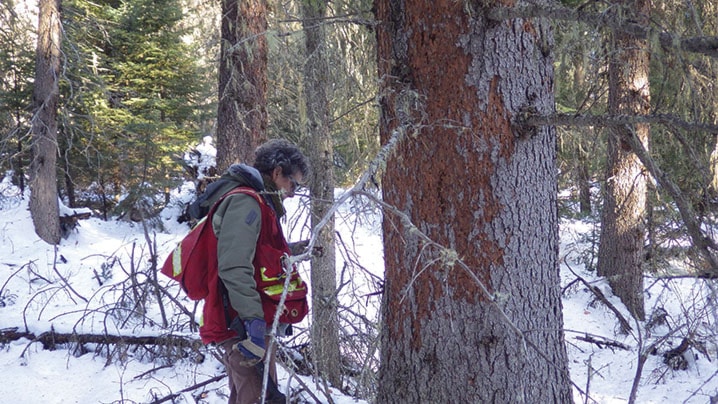Rocky Mountain House forest health officer Pam Melnick knew something was amiss during an aerial survey of the forest in 2013.
Instead of bright healthy green, the tops of some stands of tamarack trees were unusually discoloured.
This could not have been the golden colour these pretty, and remarkable “coniferous deciduous” trees turn in the fall. It was summertime and the trees were dying.
A year later, in another aerial survey in the summer of 2014, Melnick noticed spruce stands with an odd reddish appearance — also troubling signs these trees were dying.
Having just spent several years on the front lines working in the Northern Alberta Grande Prairie area dealing with the destructive tree-killing mountain pine beetle, Melnick was of course concerned.
In both instances after those aerial surveys, she soon drove out to the affected areas to see what was going on. She examined the bark of the affected trees to learn what might be killing them.
In the tamarack stand she found tamarack beetles, also known as the eastern larch beetle; in the spruce trees, she found spruce beetles. Tree beetles are specific to the type of tree they like to dine on — tamarack beetles don’t eat spruce trees for example.
The notorious mountain pine beetle has not done much to the Rocky forest. It’s not certain why the region escaped their invasion.
Melnick thinks it might be because they have to get past the Rockies west of Rocky Mountain House, whereas they did not have that obstacle in the Grande Prairie area.
While there are precautions being taken to map and monitor the spruce and tamarack beetles, at the same time the impact of tree-munching bugs isn’t all bad. Like wildfire, they actually help create a more diverse, healthier forest.
Melnick said she has now mapped 1,400 hectares of trees in the Rocky forest affected by the spruce beetle. Of that, 950 hectares have low infestation rates of less than 15 per cent and 450 hectares are around 25 per cent.
Spruce beetles hit 300,000 hectares in central British Columbia last summer, a 15 per cent increase over the previous year, she said. And to the south, 200,000 hectares have been affected in Colorado. In the Yukon and Alaska, spruce beetle populations that took out a total of 1.85 million hectares appears to be on the decline.
Eighty per cent of the infestations are in low-lying areas mainly in the Nordegg, Baptiste and Wawa river drainage areas. Trying to accurately map and predict the spruce beetle expansion, and trying to determine how long the trees have been under attack, has been difficult, Melnick said.
Beetles are trapped to figure out when and where they are flying. A chemical bait is used and the traps are checked weekly. They do not have a really good spruce beetle bait. A university student is now trying to develop a better one, said Melnick.
There is a greater concern about the impact on spruce trees because they are harvested commercially and losing stands could have an economic impact.
For every harvested tree taken, the same species must be replanted in the same area. Very few tamarack trees are harvested because they grow in swampy areas and it’s too difficult to replant them.
The spruce beetle will continue to be closely mapped and monitored, Melnick said. “We don’t understand what it’s doing. Is the population getting bigger, staying the same, and which direction it is headed?
At this point, she’s not alarmed. “I’m more curious.” They haven’t seem much of the insect in Alberta so there’s not a lot of experience with it, Melnick said.
The last recorded infestation of spruce beetle was in 1992 in the Peace River forest area. Some trees were harvested, while others were “baited” so the beetles would be attracted to them, and then burned.
“It seemed to have worked,” said Melnick. In one of the Rocky stands she discovered, the trees were already slated for commercial harvest and have since been felled.
Melnick is seeing the larger populations of the spruce beetle northwest of Rocky Mountain House. The tamarack beetle population is greater just east of Rocky and north to Drayton Valley.
Warmer winters and hotter summers may be taking their toll of the forest. When the air is warm in the winter, evergreens need more water but the ground water is frozen. Tamaracks are sensitive to water table fluctuations.
When trees are stressed they emit chemical signatures. Beetles have evolved so they pick up on that stress and off they fly to attack those trees.
She advises people who gather spruce or tamarack for firewood to check under the tree bark first. If there are beetles, people could be transferring them into their own yards and woodsheds. The beetles could fly into nearby trees as they seek food.
“Be careful about what trees you choose.”
Beetles are always present in the forest, but generally they don’t build up to kill that many trees. The mountain pine beetle may have given other beetles a bad rap.
When beetles do kill trees, it creates a gap in the forest, allowing in sunlight. New trees and plants pop up, creating greater plant and animal diversity. Dead trees provide bird and secondary insect habitat, and soil nutrients for other plants.
“When you have a diverse forest you will have diverse everything. That’s good,” said Melnick.
barr@www.reddeeradvocate.com
